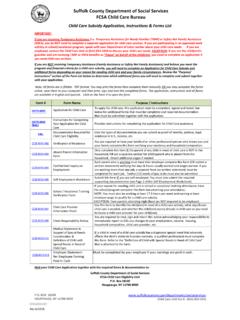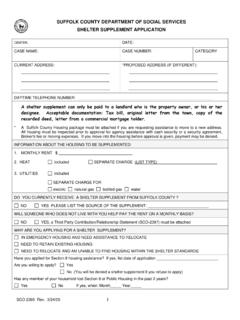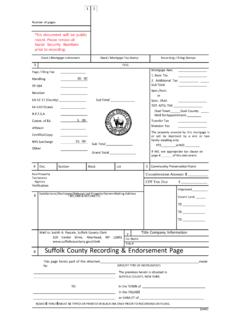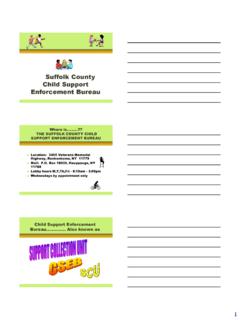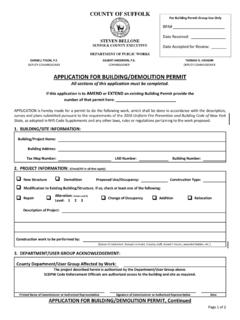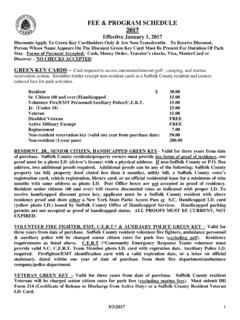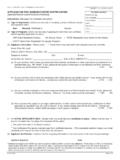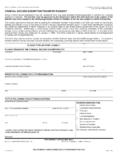Transcription of COUNTY OF SUFFOLK
1 COUNTY of SUFFOLK Department of social services Reimbursable Cost Manual For Not-for-Profit Shelters Revised August 2016 DSS Reimbursable Cost Manual Page 1 of 32 Revised August 2016 Index Description Page Index .. 1 Introduction .. 3 Allowable Expenditure Categories Salaries & Wages .. 8 Fringe Benefits .. 9 Advertising .. 10 Bad Debt .. 10 Continuing Education .. 10 Depreciation .. 10 Dues & Subscriptions .. 12 Food .. 12 Interest .. 12 Insurance .. 13 Licenses & Permits .. 13 Office Expenditure .. 13 Professional Fees .. 13 Rent Building .. 14 Rent/Leases .. 15 Repairs & Maintenance .. 16 Security .. 17 Taxes .. 17 Telephone .. 17 Training .. 17 Travel .. 18 Utilities .. 18 Other Expenditures .. 19 Unallowable Expenditures Contributions and Donations .. 20 Entertainment Costs .. 20 Fines and Penalties .. 20 Fund Raising Costs .. 20 Goodwill .. 20 Investment Management.
2 20 Personal Costs .. 20 Profits and Losses on Investments .. 20 Capital Expenditures .. 21 Revenue .. 22 DSS Reimbursable Cost Manual Page 2 of 32 Revised August 2016 Departmental Financial Statements and Forms 1. Financial Statements Cover Sheet .. 23 2. Schedule A Total Agency Expenditures .. 24 3. Schedule B Shelter Expenditures .. 25 4. Schedule B-1 Supplemental Schedules .. 26 5. Schedule C Salaries and Titles .. 27 6. Schedule D Fringe Benefits .. 28 7. Schedule E Revenue .. 29 8. 9. Schedule F Reconciliation .. Schedule G Balance Sheet .. 30 31 10. Budget Modification Request .. 32 DSS Reimbursable Cost Manual Page 3 of 32 Revised August 2016 Introduction This manual explains what costs the COUNTY of SUFFOLK will accept and not accept for reimbursement under the Emergency Homeless Shelter Program. It further specifies what costs are to be classified as Program or Administrative and which costs can be allocated between Program and Administrative.
3 When the Manual is silent on the treatment of a cost, it should not be assumed that such costs are reimbursable or that the method of allocation is deemed appropriate without written approval. Therefore all users of this Manual are strongly encouraged to contact COUNTY of SUFFOLK Department of social services Housing Division, located at 3085 Veterans Memorial Highway, Ronkonkoma, New York 11779 (mailing address: Box 18100, Hauppauge, New York 11788-8900). Allowable costs must be reasonable, necessary and directly related to an adequate program for homeless clients, as determined by the COUNTY of SUFFOLK . A cost is reasonable if, in its nature and amount, it does not exceed that which would be incurred by a prudent person under the circumstances prevailing at the time the decision was made to incur the cost. In determining reasonableness of a given cost, consideration shall be given to: A. Whether the cost is of a type generally recognized as ordinary and necessary for the operation of the approved Homeless Shelter Program.
4 B. The restraints or requirements imposed by such factors as: sound business practices; arm's length bargaining; Federal, State or local laws and regulations. C. Prices for comparable goods or services determined by reviewing similar entities. D. Whether the individuals concerned acted with prudence given their responsibilities to the entity's Board of Directors, its employees, the public at large and SUFFOLK COUNTY . E. Significant deviations from the established practices of the entity or similar entities which may unjustifiably increase the cost of the approved program. Final costs are determined upon field audit and will be considered for reimbursement provided that such costs are reasonable, necessary and directly related to the shelter program. Designation of a cost as reimbursable during the initial rate-setting process does not mean that the cost will be reimbursed upon final audit since all expenditures are subject to adjustment on field audit by the SUFFOLK COUNTY Comptroller.
5 A more detailed review of expenditures during an audit may reveal that costs deemed reimbursable during the rate-setting process for that fiscal year should not be reimbursed. Accounting records must be maintained on an accrual basis with proof of payment provided in the subsequent accounting period. Unless otherwise noted, all accounting records must be kept in accordance with Generally Accepted Accounting Principles (GAAP). Accounting books of original entry shall include asset, liability and fund balance or equity accounts, as well as DSS Reimbursable Cost Manual Page 4 of 32 Revised August 2016 expenditure and revenue accounts. Subsidiary revenue and expenditure accounts shall be maintained for, but not limited to, each program operated by the Agency. All purchases of goods or services must be supported by adequate substantiating documentation. Such documentation should include, when appropriate, the following: A. Purchase requisitions and/or purchase orders listing the goods or services purchased, the requesting party and the date of purchase, B.
6 Packing slips with shipping address clearly indicated and/or receiving reports listing the goods or services received; and, C. Invoices listing the goods or services purchased, the date of purchase and date of payment, as well as canceled checks. All contractual agreements ( , leases) underlying the purchase of goods or services must be in writing, signed and dated and must clearly delineate the nature of the goods or services to be provided and the associated charge. All related payments must be supported by itemized invoices which indicate the specific goods or services actually provided, the quantity of the goods or services actually provided, the billing rate and the total amount charged. Costs must be charged directly to specific programs whenever possible. The particular program(s) must be identified in the associated supporting documents. The COUNTY of SUFFOLK retains the right to disallow any costs that are not properly or adequately documented or that do not relate to the Emergency Homeless Shelter Program as determined by the COUNTY of SUFFOLK .
7 Any expenditures that cannot be charged directly to a specific program must be allocated across all programs and/or entities benefited by the expenditure. For example: A. Salaries of employees who perform tasks for more than one program and/or entity must be allocated among all programs and/or entities for which they work. B. The cost of supplies that are purchased for distribution among multiple programs must be allocated among these programs if direct charges are not possible. C. General maintenance and overhead expenses must be allocated among all programs and entities. Entities that allocate expenditures across programs and/or entities benefited by the expenditure must use allocation methods that are fair and reasonable, as determined by the COUNTY s fiscal representatives. Such allocation methods, as well as the statistical basis used to calculate allocation percentages, must be adequately supported by written documentation which is retained for each fiscal year for review upon audit for a minimum of seven (7) years.
8 Allocation percentages should be reviewed on an annual basis and adjusted as necessary. DSS Reimbursable Cost Manual Page 5 of 32 Revised August 2016 There are two types of allowable expenditures, Program costs and Administrative costs. Program costs are those expenditures that directly relate to the operation of the program, while Administrative costs are those that relate to the management and administration of the agency. Within the Program costs there are Operating Expenditures and Client services . Operating Expenditures are those costs necessary to the running of the program ( Rent, Wages, ). Client services are those services as listed in the Contractor Variant Terms of the contract. These costs are not subject to cost reimbursement, except to the extent included in the approved budget and reimbursement rate. Client Service costs in excess of their budgeted amount will be disallowed. Administrative costs include salary and fringe benefit costs of persons whose primary function is the management and administration of the agency.
9 Job function, not title, will ultimately determine whether a position is program or administrative in nature. Some examples of Administrative job classifications: Accountant Administrator Assistant Administrator Bookkeeper Clerical positions Comptroller Director Executive Director Financial Director Office Manager Office Worker Receptionist Secretaries If Administration fringe benefits costs are not easily distinguishable a percentage of total salaries may be used, for example: Total Salaries $600,000 Administrative Salaries 120,000 Fringe Benefit Costs 20% Administrative costs also include costs for office supplies and equipment, professional fees, as appropriate, postage, office equipment rental or depreciation, repair and maintenance, depreciation, maintenance costs for automobiles used by administrative personnel, interest, insurance, rent, and utilities. In the manual there is a notation in italic as to whether the expenditure is Program, Administrative or Allocable.
10 Those expenditures that are totally Program related are marked Program and should be claimed as such. Those expenditures that are totally Administrative are marked Administrative and should be claimed as such. Those expenditures that can be allocated between Program and Administrative are marked as Allocable. An allocation methodology must be used to determine the allocation between Program and Administrative. The allocation methodology used must be reasonable and verifiable by the Department. DSS Reimbursable Cost Manual Page 6 of 32 Revised August 2016 For any particular year, administrative expenditures, including fringe benefits on administrative salaries, will be an allowable cost to the extent that the amount does not exceed 20% of the agency s allowable program related (non-administrative) costs. If the agency s auditor has determined that it must comply with Executive Order #38 Administrative Costs cannot exceed the lesser of Executive Order 38 s cap or the 20% required by the RCM.

